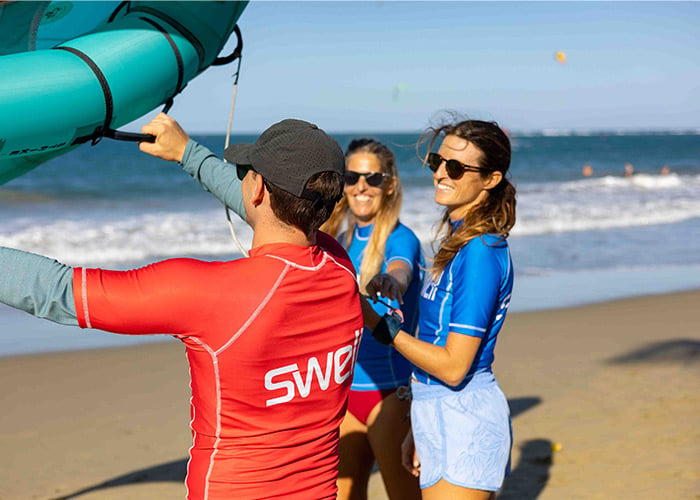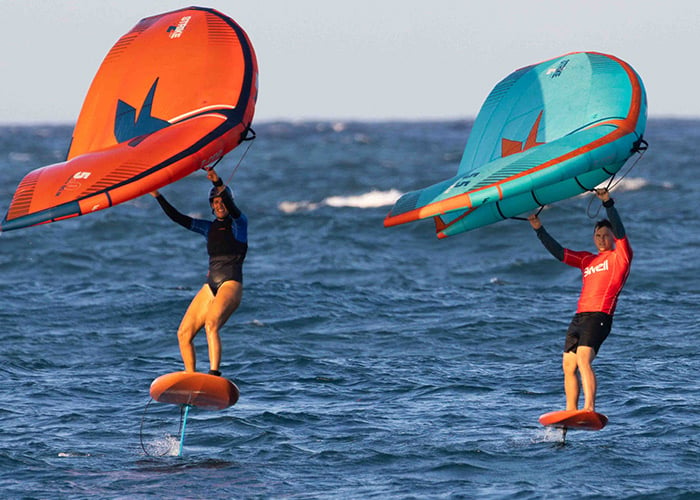What is wingfoiling (or wingsurfing) and how does it work?
Wingfoiling and wingsurfing are the same sport. Some riders spend all their time in the water with the wing and the foil riding waves, so they refer to it as wingsurfing. Either way, it combines a handheld wing sail with a hydrofoil board to glide above water using wind power. The wing catches wind for propulsion while the hydrofoil underneath lifts the board above the surface, reducing drag and creating a smooth, flying sensation. This creates an efficient, quiet ride that works in lighter winds than traditional windsurfing.
How long does it take to learn wing foiling?
Most people take around 8 to 10 hours of practice to achieve basic wingfoiling skills, typically spread over 5 sessions. Complete beginners usually need 2-3 sessions to master wing handling on land, followed by 3-5 sessions learning to ride the foil board. Prior experience with windsurfing, kitesurfing, or SUP can reduce learning time significantly but is not necessary.
What equipment do I need to start wingfoiling?
Essential wingfoiling gear includes a wing (4-6m for beginners), a foil board (100-140L volume for starters), a hydrofoil with front wing, mast, and fuselage, plus safety equipment. Budget around $2,500-$4,000 for quality beginner equipment, though rental packages are available at most water sports centers in Cabarete. It's the high cost/value of the equipment and one-on-one instruction which makes wingfoiling a relatively expensive water sport to learn.
What wind conditions are best for learning wingfoiling?
Ideal learning conditions include steady winds of 10-20 knots, flat or small chop water, and open space away from obstacles. Beginners should avoid gusty, offshore winds and crowded areas. Many instructors recommend learning in side-shore winds (as we have) with gradual depth changes, allowing safe practice in waist-deep water before progressing to deeper areas.
Is wingfoiling dangerous for beginners?
Wingfoiling has moderate risks that can be minimized with proper instruction and safety gear. The hydrofoil's sharp edges pose the main danger, making helmets and impact vests essential. Beginners should always take lessons, practice in appropriate conditions, maintain safe distances from others, and never wingfoil alone. Most injuries are minor cuts or bruises from falls. It's a widely held belief that the foil will hurt you when you fall but with professional instruction, you should be taught how to fall to prevent injury.
Do I need prior water sports experience to learn wingfoiling?
Prior water sports experience helps, but isn't required for learning wingfoiling. Windsurfing, kitesurfing, or SUP experience provides valuable wind awareness and board handling skills. However, complete beginners can successfully learn wingfoiling with quality instruction. Swimming proficiency and comfort in water are the only essential prerequisites for safe learning. In a professional lesson, you will be provided with an impact vest which also aids flotation.
What's the difference between wingfoiling and windsurfing?
Wind surfing (not to be mistaken for Foil Surfing), has been around for decades. It is one of the hardest water sports to master. Wingfoiling/surfing is the very latest water sports craze. It uses a handheld wing and hydrofoil board, whereas windsurfing uses a larger sail attached to a traditional board. Wingfoiling works in lighter winds (8+ knots vs 12+ knots), provides a quieter ride above water, and offers easier transport since the wing isn't permanently attached. Windsurfing offers more direct power transfer and doesn't require foil technique.
How much does it cost to get into wingfoiling?
Entry-level wingfoiling costs $2,500-$4,000 for complete new equipment, including wing, board, foil, and safety gear. Quality used equipment ranges from $1,500-$2,500. Lessons typically cost $80-$150 per hour or $700-$900 for multi-day packages. Many locations offer rental packages ($150-$300/day) to try the sport before purchasing equipment.








